How to Cite Creative Commons: Attribution Line Generator (free tool)
Audiodrome is a royalty-free music platform designed specifically for content creators who need affordable, high-quality background music for videos, podcasts, social media, and commercial projects. Unlike subscription-only services, Audiodrome offers both free tracks and simple one-time licensing with full commercial rights, including DMCA-safe use on YouTube, Instagram, and TikTok. All music is original, professionally produced, and PRO-free, ensuring zero copyright claims. It’s ideal for YouTubers, freelancers, marketers, and anyone looking for budget-friendly audio that’s safe to monetize.
Clear credits protect reach and revenue. Use Creative Commons the right way and your videos, posts, and podcasts move without friction. Miss a link or license and you invite takedowns, claims, and client doubts that stall launches and drain time you could spend creating.
Our CC Attribution Line Generator builds compliant credits with a full TASL block and a compact short line. It autofills license links, flags ND and NC conflicts, reminds you about ShareAlike, and adds clear change notes, with one-click copy for descriptions, captions, and end cards.
Embed This Tool on Your Website

Why CC attribution matters (and how it breaks)
Creative Commons gives creators and publishers wide freedom to share, remix, and distribute, yet the BY licenses require clear attribution every time. You credit the author, name the license, link to the source and license page, and note edits so audiences understand who made what.
Skip or mangle attribution and platforms often respond fast with strikes, blocks, or content claims that pull views and cut revenue. Clients and communities also notice, and they may question your professionalism, reduce collaboration, or drop you from shortlists when risk outweighs reward.
Attribution breaks when teams pick the wrong license, forget the link to the original, or skip the note that records what changed in the remix. It also fails when short spaces like end credits or captions squeeze the text and creators trim the essentials.
Types of Creative Commons Licenses
CC0 License: You can copy, remix, and use the work for any purpose without asking, including commercial projects, because the creator waives rights to the fullest extent allowed by law. Good practice still adds credit and a CC0 mention so teams and platforms understand the permission.
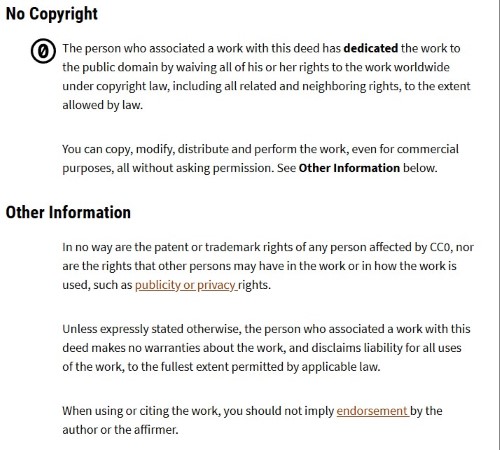
CC BY License: You can use and adapt the work for any purpose, including commercial use, as long as you give clear credit and link to the license. You also state whether you changed the work so audiences and platforms can follow the chain of contribution.

CC BY-NC License: You can remix and share the work for noncommercial projects with proper credit and a license link. If money changes hands or the use supports revenue in any way, you should treat it as commercial use and choose a different license or seek permission.
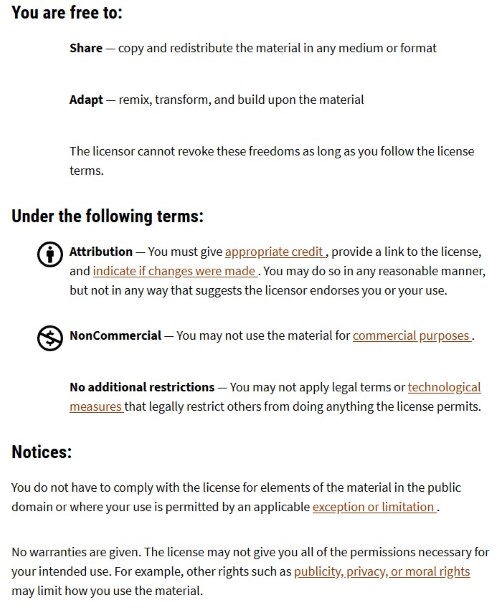
CC BY-NC-ND License: You can share the work unchanged for noncommercial use with full credit and a license link. You cannot edit, crop, subtitle, translate, or add the work to a larger remix because any tweak counts as a derivative and the license forbids it.
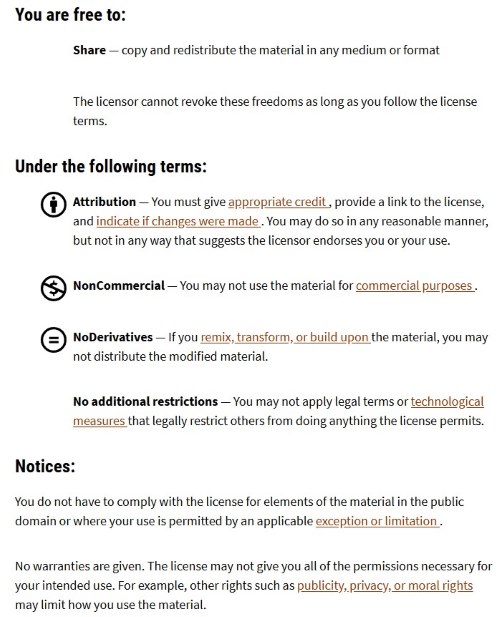
CC BY-NC-SA License: You can adapt the work for noncommercial use with credit, a license link, and a changes note. You must release your remix under the same license so anyone who builds on your version keeps it noncommercial and shares alike with the next user.
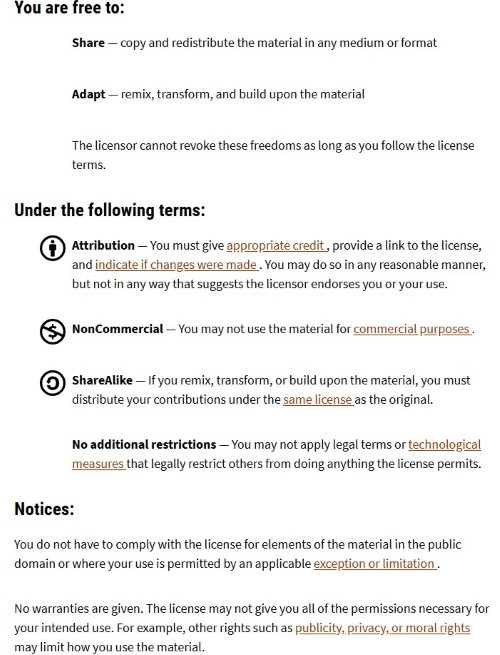
CC BY-ND: You can redistribute the work for any purpose, including commercial use, only if you keep it unchanged and provide credit with a license link. No edits, trims, overlays, translations, or mashups are allowed because those actions create a derivative.

CC BY-SA License: You can use and adapt the work for any purpose, including commercial use, with credit, a license link, and a clear changes note. Your remix must carry the same license so every future version stays open with the same share-alike rule.
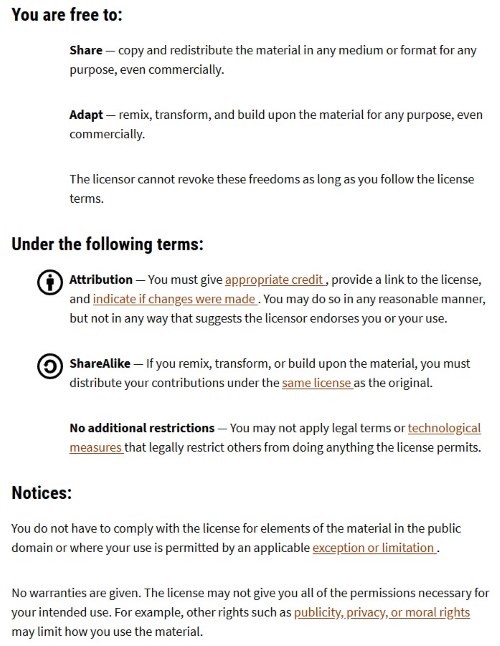
TASL (Title/Author/Source/License) in plain English
Write the exact title as it appears, or use [untitled work] if no title exists. Put the title at the start of your credit line so readers can match work confidently.
Name the creator clearly using the name or handle they publish with. If several people contributed, credit the primary author first and add others as “with” or “featuring” to avoid clutter and confusion.
Link to the original source where the work lives, not a reupload or a copy. Use a direct URL so users can verify file, check context, and contact the creator when needed.
State the license name and version, and link to the license page. Example: Creative Commons Attribution 4.0 International (CC BY 4.0) at creativecommons.org, so reviewers can read the legal code and plain summary.
Describe any changes you made, such as a crop, edit, remix, subtitles, mix, or color grade. Clear notes help others trace the lineage, respect the creator’s intent, and fix issues fast.
The five common mistakes & edge cases
Using the wrong or missing license version creates real risk. CC 4.0 differs from 3.0 and many 3.0 licenses were country ported while 4.0 is international, so record the exact version and port in your credit line and keep a screenshot of the source for proof.

Editing a NoDerivatives work violates the license because ND forbids derivatives of any size. Cropping, color correction, noise removal, time stretching, captions, subtitles, and layout composites all create a new version, so use the file verbatim or pick a different asset or seek written permission.

Applying NonCommercial content in commercial projects often crosses the line. Monetized channels, pre-roll ads, sponsorship mentions, affiliate links, fundraising, brand campaigns, paid client work, and lead generation assets count as commercial use, so choose a BY or BY-SA work or get the creator’s approval in writing.

Forgetting ShareAlike causes a licensing mismatch. If you adapt a BY-SA work you must publish your remix under the same license and keep the attribution details. Mixing BY-SA content with an incompatible license blocks release, so plan your stack early and keep every upstream license in your project notes.

Attribution collapses when the author or title is missing or the link points to an aggregator or reupload. Use the best available credit with [untitled work] and the creator’s handle if you can find it, but try to trace the original and link there, then save your discovery trail.

Short spaces, long obligations
Tight UIs need clean credits. Use compact patterns that still cover TASL: title or [untitled work], creator handle, license short name with link, and a short changes note. Fit them into end cards, lower-third captions, or podcast notes with short URLs or QR codes that resolve to the license.
When space runs out, move detail to a credits page that you control. Add a clear pointer in the tight space, like “Credits: yoursite.com/credits” or “Full attribution in description,” and make that page list TASL in full with working links, context, and timestamps.
Always keep the license link intact and mark edits in a place viewers can reach. If the UI cannot hold everything, place the core line on screen and repeat the full line in the description, show notes, pinned comment, or a project page so reviewers can verify it.
Inputs explained (and why they matter)
Each field turns legal rules into a clear, repeatable credit that teams can trust across videos, posts, and podcasts.
License flavor (BY, BY-SA, BY-NC, BY-NC-SA, BY-ND, BY-NC-ND)
This choice sets the ground rules that govern your use. BY allows broad reuse with credit, NC blocks commercial use, ND blocks edits, and SA requires the same license on derivatives, so you select the flavor that fits your project and your distribution plan.
License flavor also determines what your credit line must include. SA needs the same license on remixes, ND needs a strict “no changes” approach, and NC needs a clear noncommercial context, so the picker steers your compliance checklist before you publish.
%201.jpg)
Author/Creator
Missing creator details raise risk and reduce trust. The tool warns you to search for the original source and record the best available name so clients and platforms can verify the work when they review your credits and your license choices.
Use the creator’s preferred name or handle when you can find it. Match their spelling and capitalization, and include accents when present, so your credit respects the person behind the work and aligns with their public identity on the platform you cite.
%202.jpg)
Title of the work
Titles anchor attribution and help viewers recognize the asset you used. If the work has no title, the tool inserts the fallback [untitled work] and keeps your credit readable in end cards, descriptions, captions, and transcripts without guessing a name.
%203.jpg)
Source URL (required)
The source URL shows where you accessed the file and lets reviewers confirm context and license details. Link the original upload or creator page rather than a mirror so your audit trail points to the most authoritative version of the work.
The link functions as part of the legal credit, not an optional extra. Pasting a clean, direct URL helps platforms and clients verify the license fast, which lowers claim risk and speeds approvals when you publish or hand off deliverables to partners.
%204.jpg)
License URL (auto-filled)
The tool autofills the official Creative Commons deed page for 4.0 licenses so your credit lands on a stable, readable summary with a link to the legal code. You keep consistency across assets and save time during production and review.
If you work with older or ported licenses, you can replace the default with the correct deed page. That edit ensures your credit points to the exact version and jurisdiction of the license the creator chose when they released the work.
%205.jpg)
Changes made
Choose “none,” “minor,” or “edited-derivative” to add a clear changes statement. Crops, subtitles, mixes, cuts, color grades, translations, and layout composites count as edits, so the tool inserts a plain changes note that matches your selection and your actual workflow.
If the license is ND and you select any edit, the tool shows a warning that ND does not allow derivatives. You can then switch assets, remove edits, or seek written permission before you publish and avoid takedowns or client rework.
%206.jpg)
Asset type
Labeling the asset type helps your team track usage patterns and report across campaigns. Image, video, music, graphic, or text tags make audits faster, align with rights management systems, and support filters when you prepare credits and licensing summaries.
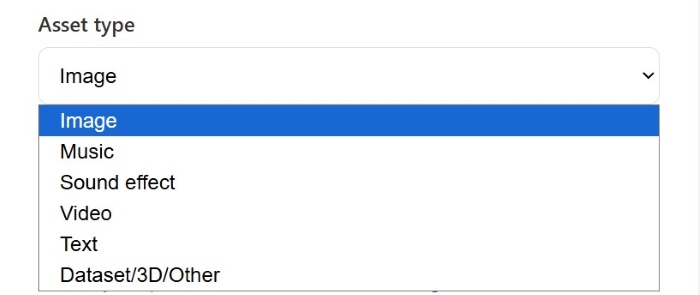
Commercial use (Yes/No/Unsure)
This input places a visual note next to your credit so producers and legal teams can spot NC conflicts early. If you select Yes or Unsure, the tool prompts a review of license flavor and project context before anything goes live.
%207.jpg)
ShareAlike toggle (contextual)
When you combine SA with edits, the toggle appears to remind you to release your derivative under the same CC license. That nudge keeps remix chains compatible and prevents license mismatches that can block distribution or force a last-minute rebuild.
%209.jpg)
Short-credit needed?
Turn this on when space is tight and you need a compact line for captions, end cards, or podcast notes. The tool trims to a compliant short pattern and links to a full credit page so you can meet obligations without cluttering the UI.
%208.jpg)
What the generator outputs
The generator gives you clean, ready-to-paste credits that match platform rules and help reviewers confirm your permissions fast.
Full Attribution block
You get a complete TASL line that lists the title or [untitled work], the creator name or handle, the source URL, and the license name with a working link. It also adds a clear changes note, so teams and platforms see exactly what you altered in your remix.
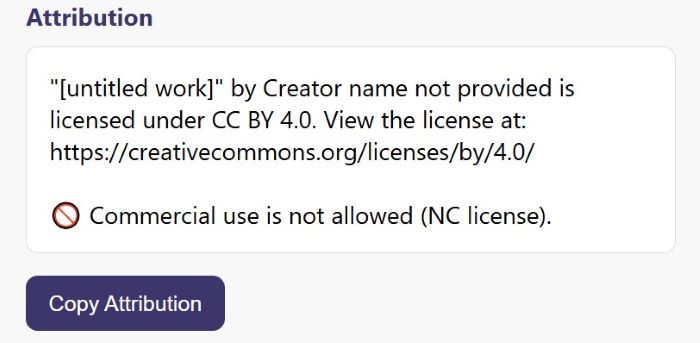
Short Credit
You get a compact credit for tight spaces that keeps the essentials, like “Title by Author (CC BY 4.0)” with an optional “[NC]” tag when the license blocks commercial use. The generator also points to your full credit page so reviewers can see the full TASL record.
![Short credit output field showing “(CC BY 4.0) [NC]” and a Copy Short Credit button.](https://storage.googleapis.com/audiodrome/Tools/How%20to%20Cite%20Creative%20Commons%20-%20Attribution%20Line%20Generator/What%20the%20generator%20outputs%202.jpg)
Copy buttons provide one-click copy for both versions.
Smart warnings
The generator flags missing author details and prompts you to look for the original source before you publish. It also warns you when you pick ND and record edits, and it reminds you to use the same license when you create derivatives from SA content.
Embed This Tool on Your Website

Step-by-step: generate a compliant line
Pick the exact Creative Commons license flavor shown on the source page. Match BY, BY-SA, BY-NC, BY-NC-SA, BY-ND, or BY-NC-ND and note the version so your credit reflects the real terms the creator set for reuse.
Add the author and title to anchor the credit. If either field is blank, use the creator’s handle or best available name and the fallback [untitled work] so audiences can trace the work without guesswork.
Paste the Source URL from the original upload, not a mirror or repost. Verify the License URL points to the correct deed page and version, and switch to a ported or older page only when the source explicitly shows it.
Choose Changes made and describe your edits clearly. Be honest about crops, captions, mixes, cuts, translations, or color grades, and remember that ND prohibits derivatives, so you either use the file as-is or pick a different asset.
Toggle Short credit when you need an end-card or caption version. The compact line keeps TASL essentials and points to a full credit page, which protects compliance in tight UIs while giving reviewers one click to the complete record.
Click Copy to grab the full or short version. Paste it into your description, end credits, show notes, or project docs, then test the links and keep a screenshot of the source so you can document your due diligence during reviews and claims.
Practical examples (ready-to-use patterns)
Image, CC BY 4.0, minor crop: Use a full TASL line with a short, honest changes note so reviewers can verify edits.
Example: “Sunset Over Harbor” by Lina Mendez, https://example.com/photo123, Creative Commons Attribution 4.0 International (CC BY 4.0), https://creativecommons.org/licenses/by/4.0/, cropped and color balanced.
Music, CC BY-SA 4.0, remix with ShareAlike: State the source and the exact edits, then mirror the license on your derivative.
Example: “Neon Streets” by Katsu Mori, https://example.com/neon-streets, Creative Commons Attribution ShareAlike 4.0 International (CC BY-SA 4.0), https://creativecommons.org/licenses/by-sa/4.0/, remixed with added drums and tempo shift, my remix released under CC BY-SA 4.0.
Video clip, CC BY-ND 4.0, resized only: ND allows redistribution without edits, so keep the file unchanged and log technical adjustments that do not create a derivative.
Example: “City Timelapse” by Keisha Adeyemi, https://example.com/city-tl, Creative Commons Attribution NoDerivatives 4.0 International (CC BY-ND 4.0), https://creativecommons.org/licenses/by-nd/4.0/, original content unchanged, exported to 1080p for delivery.
Short credit for tight space: Use a compact line that keeps the author and license while pointing to a full credits page elsewhere. Examples for captions or end cards: by Maya R. (CC BY 4.0) • by Alex T. (CC BY-SA 4.0). Add a nearby note that says Full credits at yoursite.com/credits so teams can reach the complete TASL record.
Where to place credits
Place credits where viewers can see and verify them fast. Match the placement to the medium, keep links working, and mirror a short version on screen with a full version one click away.
Web
Put the credit near the asset, such as under an image or player, so readers can connect the line to the exact work. If your layout needs a credits section at the end, add anchors or labels that map each credit to its asset without guesswork.
Make every link clickable, including the source URL and the license page, and test them before you publish. Shorten long URLs with a trustworthy shortener if needed, but keep the destination clear so reviewers land on the right page quickly.
YouTube/Vimeo
Place the full TASL line at the top of the description with working links to the source and the license. Add timestamps or markers when multiple assets appear so viewers and moderators can match credits to scenes without digging.
Add a short credit on the end card that includes the creator and license and point to the description for full details. Keep the text readable on mobile and desktop, and hold it long enough for viewers to scan it without pausing.
.jpg)
Podcasts
Put full credits in the show notes with source and license links, and read a short mention in the episode. Say the creator’s name and license in plain language so listeners who miss the notes still hear the core attribution.
.jpg)
Slides/Print
Place a short credit on the slide or page near the asset, and include a full credit list at the end of the deck or document. Number assets if needed, so the list maps cleanly to the right figures and images.
Write the license URL in text since print cannot click links. Use a short, readable URL that resolves to the official license page, and add a QR code when space allows so reviewers can open the full page on a phone.
FAQs
Tight Credits, Safer Publishing
Strong attribution is not paperwork. It is how you keep momentum, prove care for creators, and cut claim risk. Use TASL, match the license, and document edits. Put the short line on screen and the full line one click away. Ship with confidence.

At Audiodrome, we create interactive tools designed to simplify music licensing and monetization. They help creators, agencies, and businesses avoid common mistakes, save time, and stay compliant while building content that earns fairly across platforms.
Each tool translates complex rules into clear, practical guidance. Our goal is to give you confidence before publishing, ensuring your projects are protected, professional, and ready to succeed in a fast-changing media landscape.













